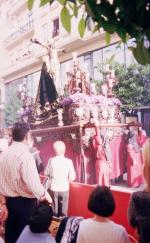

|
Semana Santa, the Spanish Holy Week, leading to EasterSemana Santa is the key date for Spain's many occasional, part-time, folk 'Christians'. For most Spaniards, religion is closely related to specific festivities spread around the year, when they can get away from the normal rut of life and attempt somehow to do more than just rest. It's probably a need in everyone to clear away the tarnish of a far from perfect life and at least, for a few days, feel good. To do this, however, the events of a typical Holy Week in Spain are only superficially linked to the true Biblical Gospel. You could say that the Spaniards get God out of the grave on Palm Sunday, parade Him round the streets of their towns and cities for five days and bury Him again on Good Friday. There is (almost) no time for celebrations of the Resurrection. By that time, if they aren't stuck in a traffic jam heading back home for the resumption of work on the Monday, they have gone to the beach for the first swim of the year... or at least to sunbathe and watch a few braver northern Europeans test the water. The processions are a great tourist attraction, both for Spaniards and for foreigners, the most colourful ones being in the southern region of Andalucía, the most serious in Castilla-León, reflecting the cold which still lingers in this part of the country. Yet the traditions are far from mere remembrances of what our Saviour did for us almost 2000 years ago. The people who process are often barefooted or wearing only socks, the processions lasting up to 12 hours. In some cases they flagelate themselves and in others they tie their arms to a beam in the shape of a cross. They call themselves penitents and hope that by partaking in the processions they will gain a little more on their way to heaven. Many carry the large and heavy platforms bearing on their shoulders the images, representations of Christ and, even more important the "virgin". And it needs to be understood that each of the images is purported to have specific powers, supporters of each image even on occasions being known to fight those of others, like football hooligans. In short, far from remembering the grace of a God who paid for our sins, here is an attempt to gain salvation for oneself. The official line of the Roman Catholic church is said to be that these traditions are clearly not following the canons of the church, but still nothing is done to curb them. On the contrary, every year they are encouraged even more.The evangelical churches' response and activityNevertheless, many among those who go out to see the processions are clearly aware of the inefficacy of this susperstition as a way to God, asking themselves if it is posible to know Him and the forgiveness of the sin which others attempt to rid themselves of in this way. there are those with serious questions. Yet on the whole, the evangelical churches seem to feel powerless to do anything to reach this religious segment of the population and tend rather to use these days as opportunities to go on retreat. While this is certainly a great opportunity, with a long weekend and for schools, a ten day holiday, it is sad that while in other lands an Easter outreach is part of the churches' agenda, it is still not the case in Spain. In 2004 Pray for Spain resumed the campaigns which OAC did during the 1980s in southern cities. More here |
